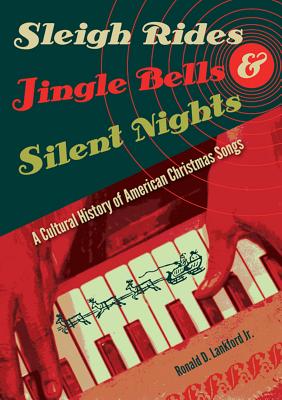
From the Toledo Blade, "Old-fashioned Christmas carols have staying power, remain cherished favorites," by Kirk Baird, on 15 December 2013 -- This month marks the 71st holiday season we’ve shared Bing Crosby’s nostalgia for a “White Christmas.”
It’s also a safe assumption none of us remembers a time when we didn’t hear Christmas carolers merrily belt out “Jingle Bells,” considering the song was first published four years before the Civil War.
So how is that these two songs and so many other decades-old holiday classics remain cherished favorites and so ingrained in our traditions?
Cultural historian Ronald Lankford wondered the same thing as he began collecting Christmas songs a few years ago, specifically: Why do we listen to these songs today, especially in this era of popular culture with quick expiration dates? And why were Americans drawn to these songs in the first place during the ’40s, ’50s, and early ’60s?

The research into those answers and more prompted him to write his recently published book, Sleigh Rides, Jingle Bells, Silent Nights: A Cultural History of American Christmas Songs ($21.95, University Press of Florida).
“Most of the pop music we listen to is basically disposable — we listen to it for a short time and then replace it with something new,” Mr. Lankford said. “Our favorite Christmas songs — “The Christmas Song,” “Let It Snow” — however, keep coming back year after year.
“Most of our Christmas favorites (“Santa Claus Is Comin’ to Town,” “Have Yourself a Merry Little Christmas”) have been around for 60 years or more ... how many non-Christmas songs do we remember from the 1940s? How many non-Christmas songs resonate across the boundaries of age, class, and musical genres? We know these songs as well as we know patriotic favorites like “The Star-Spangled Banner” and “America the Beautiful.”
Mr. Lankford said on one level we still love these songs because they are familiar, comfortable rituals.

“They remind us of Christmases gone by, filling us with misty-eyed nostalgia. We listen to the albums our parents played and it’s important to us to pass our favorite Christmas albums along to our children [or nephews and nieces].”
But on a deeper and almost spiritual level, these songs resonate with us like our patriotic songs, he said, and they remind us of what’s most important about Christmas.
“They reflect our values, desires, and hopes,” Mr. Lankford said. “While we may not be able to live up to these ideals, we very much believe that we should return home at Christmas, spend quality time with family and friends, and that we should remember those who are alone or less fortunate.”
Born in Norfolk, Va., in September, 1962, Mr. Lanksford’s formative Christmas years were the late ’60s and early ’70s, “so I grew up watching How the Grinch Stole Christmas, A Charlie Brown Christmas, and Rudolph the Red-Nosed Reindeer, and listening to Chet Atkins, the Lennon Sisters, Johnny Mathis, and Gene Autry.”

His favorite Christmas song is Willie Nelson’s “Pretty Paper” (a social message to remember others wrapped up in a great melody) and his least favorite is Elvis Presley’s “If Everyday Was Like Christmas.”
“Yes, the sentiment is fine, but Presley’s performance pales beside his superb versions of ‘Blue Christmas,’ ‘Santa Claus Is Back in Town,’ and ‘Santa Bring My Baby Back (to Me).’”
Mr. Lanksford spent more than three years researching Sleigh Rides, Jingle Bells, Silent Nights, and was forced to continually break his own rule about playing Christmas music until after Thanksgiving. He also learned some interesting stories about some of our holiday chestnuts.
For instance, “Baby, It’s Cold Outside,” a song usually associated with Christmas, became a hit in late spring of 1949, when it debuted in the Esther Williams movie Neptune’s Daughter. The song is typically performed as a duet: the man trying to convince the woman that it’s too cold outside for her to leave, while she protests that she needs to go home, though she’s rather slow in her efforts to leave.

In Neptune’s Daughter, however, one version of “Baby, It’s Cold Outside” is sung by Red Skelton and Betty Garrett, the movie’s two comics. Garrett, however, takes the man’s part and tries to convince Skelton to stay. The song also won an Oscar for Best Original Song for its composer, Frank Loesser.
And while this nugget about an additional verse to “Santa Claus Is Comin’ to Town,” wasn’t included in Sleigh Rides, Jingle Bells, Silent Nights, it’s certainly worth sharing.
Mr. Lanksford had heard a story that Haven Gillespie, the lyricist for “Santa Claus Is Comin’ to Town,” had written this famous song in a bar, and recently traced the story in a book, Angels We Have Heard on High.

“The version of ‘Santa Claus Is Comin’ to Town’ was written in 1932-33 by Gillespie while riding on a train,” he said. “Fred Coots added music, and asked his current boss — singer-performer Eddie Cantor — to sing it on his radio program. Cantor agreed but made one request: he wanted a new verse with lyrics about the Depression.
“Gillespie retired to a nearby bar, wrote the extra lyrics, and Cantor performed it — as promised — on his radio show on Thanksgiving in 1934. And what happened to the extra verse about the Depression? No one knows.” (source: The Toledo Blade)

No comments:
Post a Comment